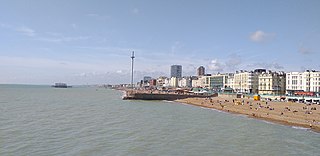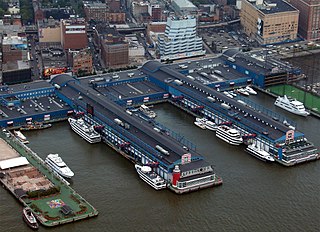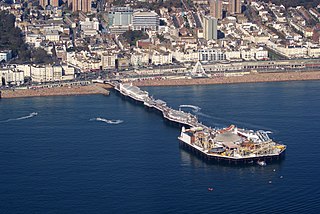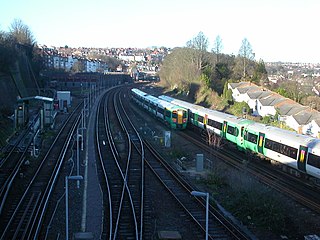New Brighton Pier may refer to:
- New Brighton Pier, Christchurch, New Zealand
- New Brighton Pier, Wallasey, England
New Brighton Pier may refer to:

Brighton is a seaside resort and one of the two main areas of the City of Brighton and Hove. Located on the southern coast of England, in the county of East Sussex, it is 47 miles (76 km) south of London.

A pier is a raised structure that rises above a body of water and usually juts out from its shore, typically supported by piles or pillars, and provides above-water access to offshore areas. Frequent pier uses include fishing, boat docking and access for both passengers and cargo, and oceanside recreation. Bridges, buildings, and walkways may all be supported by architectural piers . Their open structure allows tides and currents to flow relatively unhindered, whereas the more solid foundations of a quay or the closely spaced piles of a wharf can act as a breakwater, and are consequently more liable to silting. Piers can range in size and complexity from a simple lightweight wooden structure to major structures extended over 1,600 m (5,200 ft). In American English, a pier may be synonymous with a dock.

New Brighton is a coastal suburb of Christchurch, New Zealand, 8 kilometres (5.0 mi) east of the city centre. The 2011 Christchurch earthquakes caused significant damage in the area.

The West Pier is a pier in Brighton, England. It was designed by Eugenius Birch and opened in 1866. It was the first pier to be Grade I listed in England & Wales but has become increasingly derelict since its closure to the public in 1975. As of 2021 only a partial metal framework remains.

Volk's Electric Railway (VER) is a narrow gauge heritage railway that runs along a length of the seafront of the English seaside resort of Brighton. It was built by Magnus Volk, the first section being completed in August 1883, and is the oldest operational electric railway in the world, though it was not the first electric railway to be built. It was preceded by electrification of Miller's line in 1875, Werner von Siemens' 1879 demonstration line in Berlin and by the Gross-Lichterfelde Tramway of 1881, although none of these now remains in operation.

New Brighton is a seaside resort forming part of the town of Wallasey within the Metropolitan Borough of Wirral in Merseyside, England. Within the boundaries of the historic county of Cheshire, at the northeastern tip of the Wirral peninsula, it has sandy beaches which line the Irish Sea and mouth of the Mersey, and the UK's longest promenade at slightly over 3 mi (4.8 km).

The Brighton Palace Pier, commonly known as Brighton Pier or the Palace Pier, is a Grade II* listed pleasure pier in Brighton, England, located in the city centre opposite the Old Steine. Established in 1899, it was the third pier to be constructed in Brighton after the Royal Suspension Chain Pier and the West Pier, but is now the only one still in operation. It is managed and operated by the Eclectic Bar Group.

The Royal Suspension Chain Pier was the first major pier built in Brighton, England. Built in 1823, it was destroyed during a storm in 1896.
The British city of Brighton has featured in the many works of fiction, and other genres of popular culture, such as the following:

Public transport in Brighton and Hove, a city on the south coast of England, dates back to 1840. Brighton and Hove has a major railway station, an extensive bus service, many taxis, coach services, and it has previously had trolley buses, ferries, trams, auto rickshaws and hydrofoils.

Worthing Pier is a public pleasure pier in Worthing, West Sussex, England. Designed by Sir Robert Rawlinson, it was opened on 12 April 1862 and remains open to the public. The pier originally was a simple promenade deck 960 ft (291m) long and 15 ft (4.6m) wide. In 1888 the pier was upgraded with the width increased to 30 ft (9.2m) and the pier head increased to 105 ft (32m) for a 650-seat pavilion to be built. It is a Grade II listed building structure.

British Airways i360 is a 162 m (531 ft) observation tower on the seafront of Brighton, East Sussex, England at the landward end of the remains of the West Pier. The tower opened on 4 August 2016. From the fully enclosed viewing pod, visitors experience 360-degree views across Brighton, the South Downs and the English Channel.

Brighton Rock is a 1948 British gangster film noir directed by John Boulting and starring Richard Attenborough as violent gang leader Pinkie Brown, Carol Marsh as the innocent girl he marries, and Hermione Baddeley as an amateur sleuth investigating a murder he committed.

The London Road Viaduct is a brick railway viaduct in Brighton, part of the city of Brighton and Hove in East Sussex, England. It carries the East Coastway Line between Brighton and London Road railway stations. Built in the 1840s for the Brighton, Lewes and Hastings Railway by the locomotive engineer and railway architect John Urpeth Rastrick, the sharply curving structure has 27 arches and about 10 million bricks. It is still in constant use, and is listed at Grade II* for its historical and architectural significance.

There are 24 Grade I listed buildings in the city of Brighton and Hove, England. The city, on the English Channel coast approximately 52 miles (84 km) south of London, was formed as a unitary authority in 1997 by the merger of the neighbouring towns of Brighton and Hove. Queen Elizabeth II granted city status in 2000.

Park Crescent is a mid-19th-century residential development in the Round Hill area of Brighton, part of the English city of Brighton and Hove. The horseshoe-shaped, three-part terrace of 48 houses was designed and built by one of Brighton's most important architects, Amon Henry Wilds; by the time work started in 1849 he had 35 years' experience in the town. Wilds used the Italianate style rather than his more common Regency motifs. Three houses were replaced after the Second World War because of bomb damage, and another was the scene of one of Brighton's notorious "trunk murders" of the 1930s. The three parts of the terrace, which encircle a private garden formerly a pleasure ground and cricket pitch, have been listed at Grade II* by English Heritage for their architectural and historical importance.

The Brighton Wheel, also known during its planning and construction phase as the Brighton O and the Wheel of Excellence, was a transportable Ferris wheel installation which operated from October 2011 until May 2016 on the seafront in Brighton, part of the English city of Brighton and Hove. Situated below the East Cliff near Brighton Pier and built with private funding, its promoters anticipated that several hundred thousand visitors per year would experience the 12-minute ride. The wheel's location in a conservation area with many residential buildings proved controversial.

There have been two New Brighton Piers in New Brighton, New Zealand. The first pier, of wooden construction, opened on 18 January 1894 and was demolished on 12 October 1965. The current concrete pier was opened on 1 November 1997. It is one of the icons of Christchurch.

New Brighton Pier was a pleasure and fishing pier in New Brighton, Wallasey in England, built during the late 1860s at a length of 600 feet (180 m).